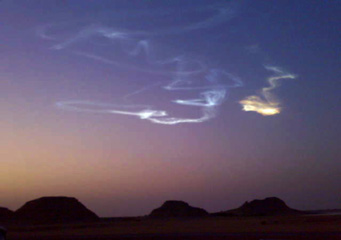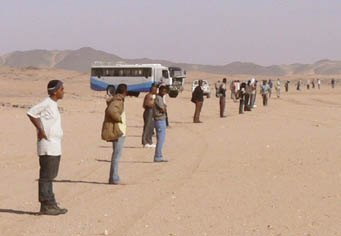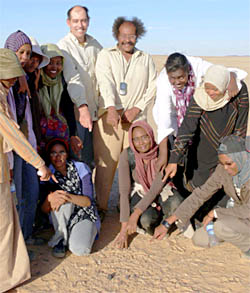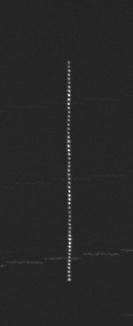This week I'm in Houston for the 40th annual Lunar & Planetary Science Conference, where 1,500 researchers have gathered to talk shop about the solar system. And indeed the big space news this week involves high-stakes interplanetary events — but the story should be datelined "Almahata Sitta, Sudan" instead of "Houston, Texas."
Our saga begins a few months ago, when Planet Earth got an unprecedented visit from a small asteroid designated 2008 TC3. A telescopic observer atop Mount Lemmon, Arizona, discovered this incoming chunk of rock on October 6th, and it slammed into the atmosphere over northern Sudan just 19 hours later. Since the 1970s astronomers have tracked down thousands of asteroids that might someday strike Earth — this is the first discovery that actually did.

When the small asteroid 2008 TC3 slammed into the atmosphere over northern Sudan on October 7, 2008, this twisted train lingered long into the predawn twilight.
Mohamed Elhassan Abdelatif Mahir (Noub NGO) / Muawia Shaddad (Univ. Khartoum) / Peter Jenniskens (SETI Institute)
Fortunately, 2008 TC3 was no bigger than an SUV, far too small to reach the ground intact. Instead, it exploded at a height of about 23 miles (37 km), lighting up the predawn darkness and frightening thousands of Sudanese making their way home after morning prayers. The asteroid's noisy arrival left a glowing train of dust in the dawn sky, presumably all that remained of it.
"We thought that was the end of the story," recalls Steve Chesley, the orbital specialist at NASA's Jet Propulsion Laboratory who pinpointed where and when 2008 TC3 would end its 4½-billion-year existence.
But a couple of weeks later Chesley got a call from Peter Jenniskens, who wanted details about the final flight path. A meteor specialist at NASA's SETI Institute in Mountain View, California, Jenniskens had recently returned from a highly successful effort to study the atmospheric reentry of a European spacecraft, and the blazing piecemeal breakup he'd witnessed gave him hope that pieces of the shattered asteroid might have survived and fallen from the sky as meteorites. All too aware of the stones' scientific potential, Jenniskens was determined to look for them — though he admits, "It was a long shot."
Six weeks later Jenniskens found himself standing in the Nubian Desert of northern Sudan with Mauwia Shaddad and a busload of 45 students and staff from the University of Khartoum, where Shaddad teaches physics. All the available information about the asteroid's track — gleaned from civilian and military satellite photos, detection networks on the ground, and eyewitness accounts — suggested that any meteorites from 2008 TC3 should lie along a roughly east-west track about 20 miles southwest of a remote Sudanese railway station called Station 6.

Students and staff from University of Khartoum prepare to hunt for meteorites in the Nubian Desert of northern Sudan.
Peter Jenniskens / SETI Institute / NASA-Ames
The makeshift search team fanned out in a long line to comb the barren ground and soon found the scientific gold they were seeking: small, black space rocks that ranged from pebbles to fist-size stones. Four days of searching (December 5-8, 2008), along with a second campaign three weeks later with even more volunteers, yielded 280 specimens with a combined weight of about 11 pounds (5 kg).
A Scientific Coup
Jenniskens's long shot had paid off. Now he had everything he needed to piece together the entire story of 2008 TC3. Chesley had computed the space rock's exact orbit before it collided with Earth, and an observing team had managed to record a spectrum of the asteroid just 2 hours before its demise using the 4.2-meter William Herschel Telescope in the Canary Islands. And, remarkably, pieces of that same asteroid were in hand.
That in itself was unprecedented. Geologists have spent decades trying to match the spectra of various meteorite types with their most likely asteroidal sources, but the match is never exact and so the associations remain unproven. "We have more than 40,000 samples of asteroids as meteorites," explains Michael Zolensky of NASA's Johnson Space Center, "but we don't know where a single one of them came from."

NASA astronomer Peter Jenniskens and physicist Muawia Shaddad (University of Khartoum) join students in celebrating the discovery of a meteorite on December 8, 2008.
Peter Jenniskens / SETI Institute / NASA-Ames
Now we do, thanks to one researcher's dogged determination. "Peter is a real hero," says Zolensky.
Once back in the U.S., Jenniskens rushed samples of the newly recovered meteorite — now officially named Almahata Sitta, the Arabic phrase for "Station 6" — to labs around the country. Those analyses revealed that the fallen stones belong to a rare meteorite class known as ureilites, dark carbon-enriched rocks that were once at least partly molten.
But even as ureilites go, the Sudanese stones are unique. Scattered here and there are blotches of carbon that have undergone extreme heating. "Of all the meteorites we've ever studied," comments analyst Andrew Steele (Carnegie Institution of Washington), "the carbon in this one has been cooked to the greatest extent." Moreover, the stones' interiors are full of holes (technically, vugs) lined with coating crystals of the magnesium-rich silicates olivine and pyroxene. Their overall porosity ranges from 10% to 25%, and they crumble easily — making it all the more remarkable that any survived.

This sequence, which combines images taken every 4 seconds, records the asteroid's dramatic changes in brightness that signified its tumbling motion.
M. Kozubal & Ron Dantowitz / Clay Center Observatory
Yet a long sequence of images recorded at the Clay Center Observatory in Brookline, Massachusetts, show that the asteroid was tumbling rapidly and wildly before it hit. So, despite its Swiss-cheese interior, 2008 TC3 must have been a single, solid rock when it slammed into our atmosphere — a loosely bound pile of rubble whirling that fast would have flung itself apart.
Meanwhile, the flat, featureless spectrum of the meteorites is a dead ringer for that of the asteroid itself. As it turns out, 2008 TC3 was also a rare and little-understood asteroidal breed known as an F type. At some point it was chipped off a larger object; conceivably that's the unnamed F asteroid designated 1998 KU2 and numbered 152679, an Earth-crosser estimated to be about 1.6 miles (2.6 km) across. Its rapid spin assures that the surface lacks a dusty coating, which means the observed spectrum reflects its true surface character.
A careful researcher, Jenniskens has kept all this very hush-hush for the past few months. But he and his extensive team of collaborators have now published their findings in today's issue of Nature (it's the cover story).
You can learn more about the flurry of activity surrounding the impact of 2008 TC3 and the recovery effort by checking out press releases issued by the SETI Institute, Carnegie Institution, and the UK's Science and Technology Facilities Council. NASA has posted many illustrations about these remarkable events here.
 2
2
Comments
Michael C. Emmert
March 27, 2009 at 10:45 am
There was quite a bit of speculation that 2008 TC3 was in fact an expended rocket body from a Mars probe, because of it's orbit. It was very important to either confirm or eliminate this hypothesis. It is now apparent that the Hohmann minimum energy transfer orbit is a chaos attractor which works in reverse of the NASA usage, in other words, it is a path to be watched for incoming space rocks. Muawia Shaddad has overcome the intense political turmoil in his country to actually do this investigation in the field. It appears from the physical characteristics of the meteorites that 2008 TC3 might have done a little aerobraking in it's history, I don't know, that's a really conplicated subject. These fragements will tell us a great deal.
You must be logged in to post a comment.
Michael C. Emmert
March 27, 2009 at 10:45 am
There was quite a bit of speculation that 2008 TC3 was in fact an expended rocket body from a Mars probe, because of it's orbit. It was very important to either confirm or eliminate this hypothesis. It is now apparent that the Hohmann minimum energy transfer orbit is a chaos attractor which works in reverse of the NASA usage, in other words, it is a path to be watched for incoming space rocks. Muawia Shaddad has overcome the intense political turmoil in his country to actually do this investigation in the field. It appears from the physical characteristics of the meteorites that 2008 TC3 might have done a little aerobraking in it's history, I don't know, that's a really conplicated subject. These fragements will tell us a great deal.
You must be logged in to post a comment.
You must be logged in to post a comment.